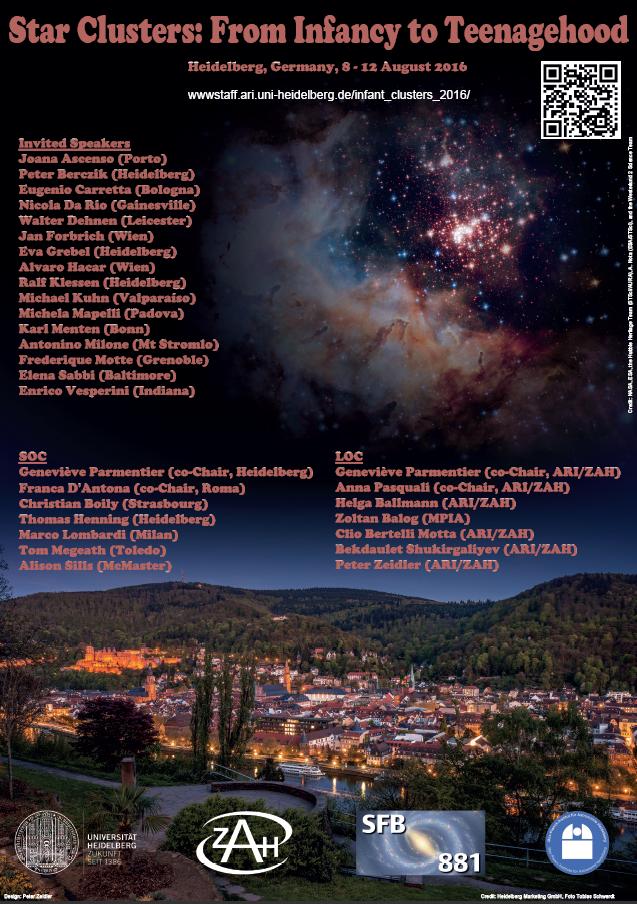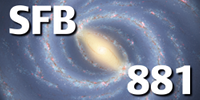Thank you to all participants for a great conference!
Invited Speakers
Joana Ascenso (Porto)
Peter Berczik (Beijing)
Eugenio Carretta (Bologna)
Nicola Da Rio (Gainesville)
Walter Dehnen (Leicester)
Jan Forbrich (Wien)
Eva Grebel (Heidelberg)
Alvaro Hacar (Wien)
Ralf Klessen (Heidelberg)
Michael Kuhn (Valparaiso)
Michela Mapelli (Padova)
Karl Menten (Bonn)
Antonino Milone (Mt Stromlo)
Frederique Motte (Paris-Saclay)
Elena Sabbi (Baltimore)
Enrico Vesperini (Indiana)
SOC
Franca D'Antona
(co-Chair; Roma)
Christian Boily (Strasbourg)
LOC
Geneviève Parmentier
(co-Chair; ARI/ZAH)
Anna Pasquali
(co-Chair; ARI/ZAH)
Helga Ballmann (ARI/ZAH)
Zoltan Balog (MPIA)
Clio Bertelli Motta (ARI/ZAH)
Bekdaulet Shukirgaliyev (ARI/ZAH)
Peter Zeidler (ARI/ZAH)
Rationale
Star cluster research is experiencing a very exciting decade. With the Atacama Large Millimeter / submillimeter Array and the Gaia astrometric satellite, we are now equipped to probe the full lifecycle of star clusters, from the properties of the molecular gas in which they form, to the properties of the stellar streams which dying clusters leave in their wake. To exploit fully and meaningfully these huge data flows, the active collaboration of observers and modellers is critically needed. What theoretical predictions are we able to make? What are the observable quantities? How well do we understand observational data?
Moreover, the time is ripe for a hard look at the physical conditions leading to the formation of clusters in the Galaxy and the Magellanic Clouds, and their imprint on the long term evolution of clusters.
Our aim is therefore also to bring together experts working on the formation of the cluster gaseous precursors with those studying the latest stages of cluster dissolution.
Particular attention will be given to the first Gyr of cluster evolution, that is, the infancy and teenagehood of clusters. This is over that age range that most clusters in the Galactic disc dissolve and, therefore, the age range over which a good understanding of cluster mass-loss mechanisms is most critically needed. Moreover, this is by that cluster age that the intriguing multiple stellar populations of globular clusters have formed. A related question is thus whether their formation can be witnessed directly in massive clusters currently in their teenagehood, or whether a key role was played by the different environmental conditions at the time of their formation.
Topics / Key Dates
Key Dates
Abstract submission opens on:
05.02.2016
Early registration opens on:
05.02.2016
Abstract submission deadline
for contributed talks: 10.04.2016
SOC decision about talk/poster
allocation released: 09.05.2016
Early registration deadline:
15.06.2016
Hotel block-reservation opens:
05.02.2016
Hotel block-reservation closes:
4-to-6 weeks before arrival,
depending on the hotel
Refund of conference fee
no longer possible after:
26.06.2016
.
Star Clusters in the Making
The relationship between molecular gas and
pre-main-sequence stars: efficiency, density and rate of star formation, gas vs. star kinematics
Star formation in clusters, associations and isolation: similarities and differences
----------------
Cluster dissolution
Gravitational potential of the Milky Way
Criticality of the first Gyr: cluster mass function evolution, mass-independent vs. mass-dependent cluster dissolution
Cluster lifecycle and the IMF
And of course topics that participants wish to bring to the front
Topics
Star Clusters in the Making
The molecular environment of cluster formation: from the outer Galactic disk to
the Central Molecular Zone
Molecular clouds / clumps / cores: (sub)structures, stability, lifetime, and
the role of stellar feedback
Finding the precursors to the next generation of clusters in the Galactic disk
Multiple stellar populations in clusters
Observational constraints ( spectroscopy / photometry )
Models of multiple population formation
( gas retention / accretion, star abundances / dynamics, IMF influence, interplay with cluster survival )
Multiple-population clusters in the Galaxy and Magellanic Clouds
Mapping multiple-population stars in the field
Conference Information
Conference Venue
Max-Planck Haus
Gerhart-Hauptmann-Strasse 36
D-69120 Heidelberg
Nearest bus/tram-stops:
- Bunsen-Gymnasium
Bus 31 from Bismarckplatz and Universitätsplatz
- Jahnstrasse
Busses 32 and 24 from the Main Train Station; also bus 21 but not later than ca. 18:15
- After getting off, follow Berliner- or Humboldt Strasse
- Please note: lines 21 and 24 are normally tram-lines. Owing to a building site, however, trams 21 and 24 are, from the Main Train Station, towards the conference venue, substituted with busses (`Ersatzverkehr').
If the weather is fine, walking from the Main Train Station or Bismarckplatz is also a possibility
For maps of Heidelberg and its public transport network, see
Traveling to and Staying in Heidelberg
For any other information, please ask the reception of your hotel.
Social Activities, Wd 10.08.2016
Talk Duration
Invited talks (35min in total):
30min + 5min for discussions.
Contributed talks (20min in total):
15min + 5min for discussions.
Poster Guidelines
Posters can be up to A0 (portrait) in size.
To enhance poster visibility, the SOC has planned two poster-viewing sessions of 30 minutes each.
You will also have the opportunity to present your poster in one slide/one minute during a dedicated poster session on the first day of the conference.
Proceedings
We will not have proceedings but will collect talks and posters, and put them online after the meeting.
Conference Schedule
On-site registration starts at 8:15AM on 08.08.2016.
Registration / Abstract Submission / Financial Support
Registration
- Late/On-site registration fee:
230Eur
- OnLine registration is now closed. Only onSite registration is possible.
Abstract Submission
This link will take you to the ConfTool system of the Congress and Conference Management of Heidelberg University. Only registered participants can now use it. Make sure that your browser's JavaScript functionality is enabled.
Registration Fee Waiver for
PhD Students
Conference Program
Day 1 - Monday 08.08.2016 (Morning)
Day 1 - Monday 08.08.2016 (Afternoon)
Day 2 - Tuesday 09.08.2016 (Morning)
Day 2 - Tuesday 09.08.2016 (Afternoon)
Day 3 - Wednesday 10.08.2016 (Morning)
| Session 2 |
Multiple Stellar Populations in Clusters |
|
09:15 - 09:50
|
Eugenio Carretta
(INAF-Osservatorio Astronomico di Bologna, Italy)
|
Spectroscopic Evidence of Multiple Stellar Populations in Clusters
|
|
09:50 - 10:10
|
Anna Fabiola Marino
(Australian National University, Australia)
|
Chemical Abundances Along The Colour-Magnitude Diagram Of 47 Tucanae
|
|
10:10 - 10:30
|
Angela Bragaglia
(INAF-Osservatorio Astronomico di Bologna, Italy)
|
Observational Test Of The Minimum Cluster Mass And Age To Have Multiple Populations
|
| 10:30 - 11:00 |
Coffee Break |
|
11:00 - 11:35
|
Antonino Milone
(Mt Stromlo Observatory, Australia)
|
Multiple Stellar Populations In Young, Intermediate-age, And Old Globular Clusters
|
|
11:35 - 11:55
|
Domenico Nardiello
(Università degli Studi di Padova, Italy)
|
Multiple Stellar Populations in Globular Clusters: Last Results
|
|
11:55 - 12:15
|
Clio Bertelli Motta
(University of Heidelberg, Germany)
|
Testing Stellar Evolution Models with APOGEE Observations of the Old Open Cluster M67
|
|
12:15 - 12:35
|
Donald M. Terndrup
(Ohio State University, USA)
|
How Well Does Stellar Rotation Inform Us About Winds, Mass Loss, and Star Formation?
|
|
12:35 - 12:40
|
Martin Netopil
(Masaryk University, Czech Republic)
|
A comment about the official IAU cluster commission (H4) newsletter SCYON
|
| |
| |
| 12:40 - |
Free Afternoon
|
| |
| |
| 15:00 - 18:00 |
Neckar cruise (departure point: Kongresshalle; online-registration needed)
|
| |
| |
| 18:30 - 21:00 |
Conference Dinner at Heidelberger Kulturbrauerei (online-registration needed)
|
| |
| End of Day 3
|
Day 4 - Thursday 11.08.2016 (Morning)
Day 4 - Thursday 11.08.2016 (Afternoon)
Day 5 - Friday 12.08.2016 (Morning)
Traveling to and Staying in Heidelberg
By plane
From Frankfurt Airport (FRA) to Heidelberg (ca. 90km), you have the following options:
From Stuttgart Airport (STR) to Heidelberg:
- Take the S-Bahn from the airport to Stuttgart Hauptbahnhof (ca. 25 minutes ride). Continue by
train to "Heidelberg Hbf" (see To Heidelberg by train)
Accommodation
Participants to the conference can use one of the following options:
- A number of rooms have been booked at a preferential rate in several hotels in Heidelberg, 7 - 13 August 2016. You can book one of those by following this link of Heidelberg Marketing GmbH. Additional instructions about how to proceed can be found here (pdf file).
- Should you wish to find cheaper prices, you may consider:
Note that for these three hotels, no block booking has been made and, therefore, no special rate applies.
We wish you a pleasant stay in Heidelberg!
By train
See train schedules of the Deutsche Bahn. Your end station is "Heidelberg Hbf"
(Hauptbahnhof-Main Train Station)
Public transportation in Heidelberg
How to reach the Conference Venue: see
Conference Information
Finding your way in Heidelberg
This map helps you locate: conference-related sites (red stars), banks ('ATM'), Universitätsplatz and Bismarckplatz (red points), the Main Train Station, arrival/departure point of the Lufthansa Shuttle, taxis, restaurants, supermarkets, ...
Conference Poster / Latest News / Conference Pictures
Conference Poster
15MB pdf-file:

Latest News
All dates given on this webpage are in DD.MM.YYYY format.
08.08.2016: conference starts
08.07.2016: list of registered participants released
22.06.2016: conference poster available
27.05.2016: conference program released and
poster-information added
09.05.2016: SOC decisions about contributed-talk
applications: all emails sent.
10.04.2016: Contributed-talk abstract submission closes
10.02.2016: Conference announcement
05.02.2016: Website goes online, registration and
abstract submission open
13.01.2016: Invited speakers selected
27.11.2015: Conference pre-announcement
24.11.2015: SOC assembled
06.11.2015: Funding application submitted by
Parmentier and Henning to the
Managing Board of SFB 881
Background Image Credit
Conference-Poster Image Credit
Contact
Geneviève Parmentier
Universität Heidelberg
Astronomisches Rechen-Institut
Mönchhofstrasse 12-14
69120 Heidelberg
Germany
Phone: +49 6221 54 1836
Fax: +49 6221 54 1888
